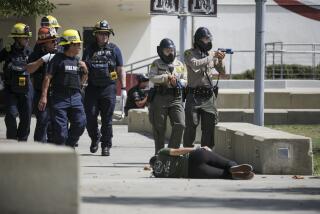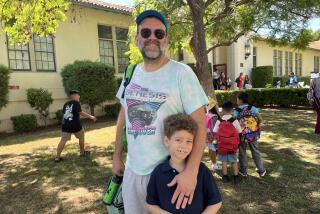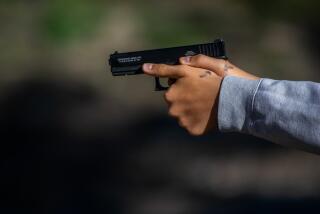Op-Ed: Active shooter drills normalize atrocities
The day of the mass shooting in San Bernardino, my sonâs high school was placed on a short lockdown. He was remarkably nonchalant when I picked him up. âIt was just a Level One,â he said, brushing off my concerns. âEverythingâs fine now.â
It wasnât, in fact; the horror was still unfolding and would come even closer to home that afternoon, when law enforcement found a veritable arsenal in the assailantsâ Redlands townhouse. But I recognized my sonâs need to normalize what had happened.
I listened attentively as he explained the difference in lockdown levels: A Level One is when an active shooter is in the town or city; a Level Two is when the shooter is in the neighborhood; and a Level Three is when the shooter is actually on campus.
Preparedness is key. But there are possible downsides to these morbid war games.
During a Level One, my son explained, teachers lock their classroom doors and lower the blinds. Some continue with the dayâs lesson plans. Others choose to take the more extreme measures required during a Level Two or Three. They turn off the lights and instruct the kids to turn off their cellphones. They ask everyone to gather silently in the corner of the room farthest from the door and windows.
Once theyâre given the all-clear signal, teachers may take additional time away from instruction to discuss what just happened, knowing that itâs hard for kids to snap right back to Latin or biology when theyâve just been contemplating a shooter on the loose.
I may be 33 years my sonâs senior, but in many ways heâs more worldly. When I was in high school in the San Fernando Valley in the 1980s, the terms âactive shooter,â âlockdownâ and âshelter in placeâ werenât buzzwords. âActive shooterâ entered the lexicon not long after the Columbine massacre in 1999. âLockdownâ has been around longer, but until recently was most commonly used in prisons.
In the wake of the Sandy Hook attack, the Department of Education released guidelines for school emergency plans. Specific requirements vary by state. Californiaâs Education Code doesnât mandate âactive shooterâ exercises but does expect school districts to develop comprehensive safety procedures for each campus. Some schools around the country, eager to stay ahead of the curve, have taken it upon themselves to stage simulations complete with uniformed officers, fake blood and student actors. Sometimes schools announce drills in advance; sometimes not. The goal is to minimize the âfreezeâ response, which can prove fatal. Instead, participants learn to âRun, Hide, Fight.â
I get it: Preparedness is key. But there are possible downsides to these morbid war games. For starters, we donât know how kids may respond to them in the long term. (Thereâs little research on the subject.) And they scare the hell out of the community. An âactive shooterâ drill at an Irvine elementary school in August was realistic enough that surprised neighbors called the police. Responding officers were unaware of the drill.
Our schools are confronting the new normal through preparations that would once have seemed ridiculous. At my daughterâs elementary school, the Parent Teacher Assn. voted to buy portable toilets and privacy curtains for kids to use during lockdowns. It was a prudent decision. After the schoolâs last lockdown, my daughter told me that a fellow second-grader had to pee in a trash can, shielded by a flip chart the teacher set up to provide privacy.
Somehow, weâve gotten to the point in California where, like earthquakes, school shootings are an acknowledged part of our kidsâ lives.
Each October, the state goes all out publicizing the Great California ShakeOut. The chirpy online âShakeOut Shopâ offers T-shirts, coffee mugs and buttons reminding Californians to âDrop, Cover and Hold Onâ in the event of an earthquake. Can a similarly upbeat âBullet-Wiseâ preparedness day be far behind?
Teaching kids to âRun, Hide, Fightâ reinforces the nihilistic view that mass shootings are inevitable, diverting energy from the struggle to stop them. Instead of crafting catchy phrases to help kids stay safe in the event of an atrocity, we should work toward stronger gun ownership background checks and assault-weapon restrictions. We need more than preparedness; we need prevention.
Lisa Lewis is a writer based in Redlands. Her last piece for the Los Angeles Times was on fundraising to keep high school sports afloat.
Follow the Opinion section on Twitter @latimesopinion and Facebook
More to Read
A cure for the common opinion
Get thought-provoking perspectives with our weekly newsletter.
You may occasionally receive promotional content from the Los Angeles Times.










